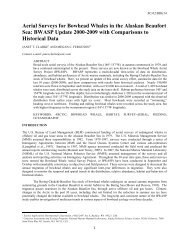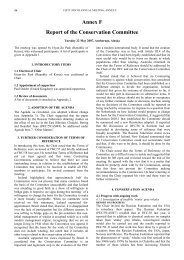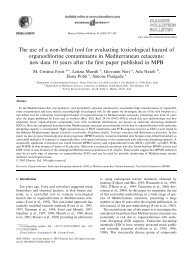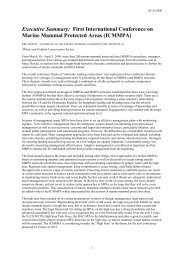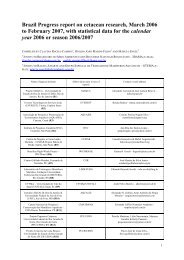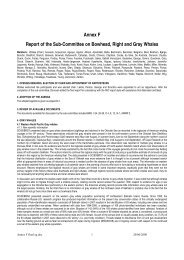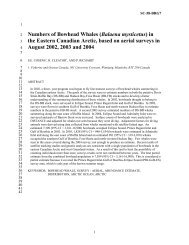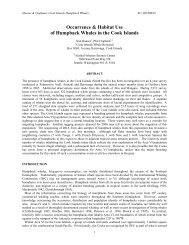bycatch of humpback whales in artisanal fishing gear in ecuador ...
bycatch of humpback whales in artisanal fishing gear in ecuador ...
bycatch of humpback whales in artisanal fishing gear in ecuador ...
You also want an ePaper? Increase the reach of your titles
YUMPU automatically turns print PDFs into web optimized ePapers that Google loves.
Bycatch rate and total mortality<br />
Consider<strong>in</strong>g the total number <strong>of</strong> <strong>whales</strong> recorded (n=349) and the three <strong>whales</strong> found entangled, a<br />
<strong>bycatch</strong> rate <strong>of</strong> 0.0086 was calculated. Extrapolat<strong>in</strong>g this value to the entire population estimated to<br />
be 2,917 animals <strong>in</strong> the period 2003-2004 (Félix et al., 2006), around 25 <strong>whales</strong> (C.I. 95% 20-32)<br />
could be the total <strong>bycatch</strong> <strong>in</strong> the breed<strong>in</strong>g season 2005 <strong>in</strong> Ecuador.<br />
DISCUSSION<br />
The entanglement <strong>of</strong> <strong>humpback</strong> <strong>in</strong> <strong>artisanal</strong> gillnets <strong>in</strong> Ecuador cont<strong>in</strong>ued <strong>in</strong> 2005 likely with similar<br />
<strong>in</strong>tensity as previous years. Besides the three cases reported here, the authors knew <strong>of</strong> two other<br />
cases which occurred <strong>in</strong> other parts <strong>of</strong> the country <strong>in</strong>volv<strong>in</strong>g beached <strong>whales</strong> with gillnets around their<br />
bodies. Also, sailors and naturalist guides reported entangled <strong>whales</strong> <strong>of</strong>f Sal<strong>in</strong>as every year s<strong>in</strong>ce<br />
whalewatch<strong>in</strong>g started here <strong>in</strong> 2001; at least three cases were reported <strong>in</strong> 2003 (Félix and Haase,<br />
2003). Other cases <strong>of</strong> entanglements were reported at La Plata Island, 100km north <strong>of</strong> Sal<strong>in</strong>as, a calf<br />
<strong>in</strong> 1998 (Scheidat et al., 2000) and six adults or sub-adults animals <strong>in</strong> 2001 (Álava et al., 2005).<br />
It is believed that the entanglement <strong>of</strong> <strong>humpback</strong> <strong>whales</strong> <strong>in</strong> <strong>artisanal</strong> gillnets <strong>in</strong> Ecuador and Colombia<br />
have ma<strong>in</strong>ta<strong>in</strong>ed an <strong>in</strong>creas<strong>in</strong>g trend <strong>in</strong> the last decade (Capella et al., 2001; Álava et al., 2005), but<br />
there not pro<strong>of</strong> as no reliable assessments have been made. So far, data on beached animals have<br />
provided a gross idea <strong>of</strong> the <strong>bycatch</strong> level but not its magnitude, s<strong>in</strong>ce not every entangled or dead<br />
whale ended up on the beach. Our estimate provides a first approach to establish the total <strong>bycatch</strong> <strong>in</strong><br />
Ecuador by us<strong>in</strong>g a measurable search<strong>in</strong>g effort and therefore allow<strong>in</strong>g extrapolation for the entire<br />
population that reach Ecuador. However, it is not possible to establish the impact on the population<br />
s<strong>in</strong>ce no data on survival after the entanglement are available. Photographs <strong>of</strong> the animals found <strong>of</strong>f<br />
Sal<strong>in</strong>as <strong>in</strong> 2005 showed different level <strong>of</strong> seriousness with likely different survival chances for the<br />
<strong>whales</strong>; therefore, it is not possible to obta<strong>in</strong> an overall rate.<br />
The fate <strong>of</strong> the entangled <strong>whales</strong> was unknown, but previous records <strong>of</strong> stranded animals on the<br />
coast <strong>of</strong> Ecuador suggest that at least some <strong>whales</strong> die few weeks later after the entanglement (e.g.<br />
Félix et al, 1997; Álava et al, 2005). These animals would die <strong>of</strong> exhaustion or would be easy preyed<br />
upon by orcas and big sharks at sea. In the female with calf case (#2), the impact would be even<br />
bigger, s<strong>in</strong>ce calves also would die afterwards. Whatever the proportion <strong>of</strong> animals dy<strong>in</strong>g as a<br />
consequence <strong>of</strong> the entanglement, it may have a significant impact <strong>in</strong> the recovery <strong>of</strong> this population.<br />
S<strong>in</strong>ce both fish<strong>in</strong>g effort and whale population are <strong>in</strong>creas<strong>in</strong>g <strong>in</strong> Ecuador (see Félix et al, 2006), it is<br />
expected that the number <strong>of</strong> entangled <strong>whales</strong> will cont<strong>in</strong>ue <strong>in</strong>creas<strong>in</strong>g <strong>in</strong> the future if measurements<br />
are not taken on short-terms. Several management actions have been proposed by Ecuadorian<br />
researches <strong>in</strong> order to reduce the level <strong>of</strong> cetacean <strong>bycatch</strong>, <strong>in</strong>clud<strong>in</strong>g directed research; education<br />
programs for <strong>artisanal</strong> fishermen; use <strong>of</strong> sound devices; closed seasons; change <strong>of</strong> fish<strong>in</strong>g <strong>gear</strong>;<br />
creation <strong>of</strong> rescue teams; among others (Félix and Samaniego, 2004; Félix et al, 1997; Álava et al,<br />
2005; Félix and Haase, 2005). Some <strong>of</strong> these measures could be implemented on a temporary basis<br />
dur<strong>in</strong>g the <strong>humpback</strong> whale breed<strong>in</strong>g season or <strong>in</strong> specific sites <strong>of</strong> higher density <strong>of</strong> <strong>whales</strong>. With<br />
exception <strong>of</strong> a limited number <strong>of</strong> educative talks dur<strong>in</strong>g the seasons 2002 and 2003 no other actions<br />
have been taken by fish<strong>in</strong>g authorities.<br />
Consider<strong>in</strong>g that such high <strong>bycatch</strong> rate <strong>of</strong> a long-migrat<strong>in</strong>g species as the <strong>humpback</strong> whale has<br />
transboundary implicitness, we ask to the Scientific Committee <strong>of</strong> the International Whal<strong>in</strong>g<br />
Commission to urge Ecuadorian authorities the adoption <strong>of</strong> measures to reduce the level <strong>of</strong> <strong>bycatch</strong><br />
on short-term. We also recommend that any proposal and or decision to be taken to address the<br />
<strong>bycatch</strong> problem must be agreed with relevant stakeholders <strong>in</strong>clud<strong>in</strong>g fish<strong>in</strong>g authorities, <strong>artisanal</strong><br />
fishermen associations, NGOs, among others.<br />
ACKNOWLEDGEMENTS<br />
We thank tourist operators <strong>in</strong> Sal<strong>in</strong>as who allowed us us<strong>in</strong>g their vessels for this study. The <strong>humpback</strong><br />
whale research <strong>in</strong> Ecuador is supported by the Whale and Dolph<strong>in</strong> Conservation Society (WDCS).<br />
4




